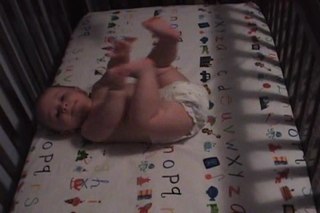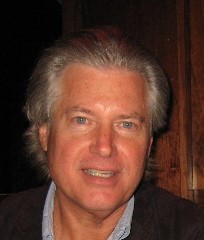Language acquisition is the process by which humans acquire the capacity to perceive and comprehend language. In other words, it is how human beings gain the ability to be aware of language, to understand it, and to produce and use words and sentences to communicate.

Neam "Nim" Chimpsky was a chimpanzee and the subject of an extended study of animal language acquisition at Columbia University. The project was led by Herbert S. Terrace with the linguistic analysis headed up by psycholinguist Thomas Bever. Within the context of a scientific study, Chimpsky was named as a pun on linguist Noam Chomsky, who posits that humans are "wired" to develop language.

Babbling is a stage in child development and a state in language acquisition during which an infant appears to be experimenting with uttering articulate sounds, but does not yet produce any recognizable words. Babbling begins shortly after birth and progresses through several stages as the infant's repertoire of sounds expands and vocalizations become more speech-like. Infants typically begin to produce recognizable words when they are around 12 months of age, though babbling may continue for some time afterward.

Research into great ape language has involved teaching chimpanzees, bonobos, gorillas and orangutans to communicate with humans and each other using sign language, physical tokens, lexigrams, and imitative human speech. Some primatologists argue that the use of these communication methods indicate primate "language" ability, though this depends on one's definition of language. The cognitive tradeoff hypothesis suggests that human language skills evolved at the expense of the short-term and working memory capabilities observed in other hominids.
Cognitive development is a field of study in neuroscience and psychology focusing on a child's development in terms of information processing, conceptual resources, perceptual skill, language learning, and other aspects of the developed adult brain and cognitive psychology. Qualitative differences between how a child processes their waking experience and how an adult processes their waking experience are acknowledged. Cognitive development is defined as the emergence of the ability to consciously cognize, understand, and articulate their understanding in adult terms. Cognitive development is how a person perceives, thinks, and gains understanding of their world through the relations of genetic and learning factors. There are four stages to cognitive information development. They are, reasoning, intelligence, language, and memory. These stages start when the baby is about 18 months old, they play with toys, listen to their parents speak, they watch TV, anything that catches their attention helps build their cognitive development.
Language development in humans is a process which starts early in life. Infants start without knowing a language, yet by 10 months, babies can distinguish speech sounds and engage in babbling. Some research has shown that the earliest learning begins in utero when the fetus starts to recognize the sounds and speech patterns of its mother's voice and differentiate them from other sounds after birth.
Ellen Bialystok, OC, FRSC is a Canadian psychologist and professor. She carries the rank of Distinguished Research Professor at York University in Toronto, Ontario where she is director of the Lifespan Cognition and Development Lab. She is also an associate scientist at the Rotman Research Institute of the Baycrest Centre for Geriatric Care.
Bimodal bilingualism is an individual or community's bilingual competency in at least one oral language and at least one sign language, which utilize two different modalities. An oral language consists of a vocal-aural modality versus a signed language which consists of a visual-spatial modality. A substantial number of bimodal bilinguals are children of deaf adults (CODA) or other hearing people who learn sign language for various reasons. Deaf people as a group have their own sign language(s) and culture that is referred to as Deaf, but invariably live within a larger hearing culture with its own oral language. Thus, "most deaf people are bilingual to some extent in [an oral] language in some form". In discussions of multilingualism in the United States, bimodal bilingualism and bimodal bilinguals have often not been mentioned or even considered. This is in part because American Sign Language, the predominant sign language used in the U.S., only began to be acknowledged as a natural language in the 1960s. However, bimodal bilinguals share many of the same traits as traditional bilinguals, as well as differing in some interesting ways, due to the unique characteristics of the Deaf community. Bimodal bilinguals also experience similar neurological benefits as do unimodal bilinguals, with significantly increased grey matter in various brain areas and evidence of increased plasticity as well as neuroprotective advantages that can help slow or even prevent the onset of age-related cognitive diseases, such as Alzheimer's and dementia.
Bilingual–Bicultural or Bi-Bi deaf education programs use sign language as the native, or first, language of Deaf children. In the United States, for example, Bi-Bi proponents state that American Sign Language (ASL) should be the natural first language for deaf children in the United States, although the majority of deaf and hard of hearing being born to hearing parents. In this same vein, the spoken or written language used by the majority of the population is viewed as a secondary language to be acquired either after or at the same time as the native language.
The critical period hypothesis or sensitive period hypothesis claims that there is an ideal time window of brain development to acquire language in a linguistically rich environment, after which further language acquisition becomes much more difficult and effortful. It is the subject of a long-standing debate in linguistics and language acquisition over the extent to which the ability to acquire language is biologically linked to developmental stages of the brain. The critical period hypothesis was first proposed by Montreal neurologist Wilder Penfield and co-author Lamar Roberts in their 1959 book Speech and Brain Mechanisms, and was popularized by Eric Lenneberg in 1967 with Biological Foundations of Language.
Developmental linguistics is the study of the development of linguistic ability in an individual, particularly the acquisition of language in childhood. It involves research into the different stages in language acquisition, language retention, and language loss in both first and second languages, in addition to the area of bilingualism. Before infants can speak, the neural circuits in their brains are constantly being influenced by exposure to language. Developmental linguistics supports the idea that linguistic analysis is not timeless, as claimed in other approaches, but time-sensitive, and is not autonomous – social-communicative as well as bio-neurological aspects have to be taken into account in determining the causes of linguistic developments.
Patricia Katherine Kuhl is a Professor of Speech and Hearing Sciences and co-director of the Institute for Learning & Brain Sciences at the University of Washington. She specializes in language acquisition and the neural bases of language, and she has also conducted research on language development in autism and computer speech recognition. Kuhl currently serves as an associate editor for the journals Journal of the Acoustical Society of America, Neuroscience, and Developmental Science.
Neuroscience of multilingualism is the study of multilingualism within the field of neurology. These studies include the representation of different language systems in the brain, the effects of multilingualism on the brain's structural plasticity, aphasia in multilingual individuals, and bimodal bilinguals. Neurological studies of multilingualism are carried out with functional neuroimaging, electrophysiology, and through observation of people who have suffered brain damage.

John L. Locke is an American biolinguist who has contributed to the understanding of language development and the evolution of language. His work has focused on how language emerges in the social context of interaction between infants, children and caregivers, how speech and language disorders can shed light on the normal developmental process and vice versa, how brain and cognitive science can help illuminate language capability and learning, and on how the special life history of humans offers perspectives on why humans are so much more intensely social and vocally communicative than their primate relatives. In recent time he has authored widely accessible volumes designed for the general public on the nature of human communication and its origins.
Prelingual deafness refers to deafness that occurs before learning speech or language. Speech and language typically begin to develop very early with infants saying their first words by age one. Therefore, prelingual deafness is considered to occur before the age of one, where a baby is either born deaf or loses hearing before the age of one. This hearing loss may occur for a variety of reasons and impacts cognitive, social, and language development.
Manual babbling is a linguistic phenomenon that has been observed in deaf children and hearing children born to deaf parents who have been exposed to sign language. Manual babbles are characterized by repetitive movements that are confined to a limited area in front of the body similar to the sign-phonetic space used in sign languages. In their 1991 paper, Pettito and Marentette concluded that between 40% and 70% of deaf children's manual activity can be classified as manual babbling, whereas manual babbling accounts for less than 10% of hearing children’s manual activity. Manual Babbling appears in both deaf and hearing children learning American Sign Language from 6 to 14 months old.
Language acquisition is a natural process in which infants and children develop proficiency in the first language or languages that they are exposed to. The process of language acquisition is varied among deaf children. Deaf children born to deaf parents are typically exposed to a sign language at birth and their language acquisition follows a typical developmental timeline. However, at least 90% of deaf children are born to hearing parents who use a spoken language at home. Hearing loss prevents many deaf children from hearing spoken language to the degree necessary for language acquisition. For many deaf children, language acquisition is delayed until the time that they are exposed to a sign language or until they begin using amplification devices such as hearing aids or cochlear implants. Deaf children who experience delayed language acquisition, sometimes called language deprivation, are at risk for lower language and cognitive outcomes. However, profoundly deaf children who receive cochlear implants and auditory habilitation early in life often achieve expressive and receptive language skills within the norms of their hearing peers; age at implantation is strongly and positively correlated with speech recognition ability. Early access to language through signed language or technology have both been shown to prepare children who are deaf to achieve fluency in literacy skills.
Language deprivation in deaf and hard-of-hearing children is a delay in language development that occurs when sufficient exposure to language, spoken or signed, is not provided in the first few years of a deaf or hard of hearing child's life, often called the critical or sensitive period. Early intervention, parental involvement, and other resources all work to prevent language deprivation. Children who experience limited access to language—spoken or signed—may not develop the necessary skills to successfully assimilate into the academic learning environment. There are various educational approaches for teaching deaf and hard of hearing individuals. Decisions about language instruction is dependent upon a number of factors including extent of hearing loss, availability of programs, and family dynamics.
Language exposure for children is the act of making language readily available and accessible during the critical period for language acquisition. Deaf and hard of hearing children, when compared to their hearing peers, tend to face more hardships when it comes to ensuring that they will receive accessible language during their formative years. Therefore, deaf and hard of hearing children are more likely to have language deprivation which causes cognitive delays. Early exposure to language enables the brain to fully develop cognitive and linguistic skills as well as language fluency and comprehension later in life. Hearing parents of deaf and hard of hearing children face unique barriers when it comes to providing language exposure for their children. Yet, there is a lot of research, advice, and services available to those parents of deaf and hard of hearing children who may not know how to start in providing language.
Karen Denise Emmorey is a linguist and cognitive neuroscientist known for her research on the neuroscience of sign language and what sign languages reveal about the brain and human languages more generally. Emmorey holds the position of Distinguished Professor in the School of Speech, Language, and Hearing Sciences at San Diego State University, where she directs the Laboratory for Language and Cognitive Neuroscience and the Center for Clinical and Cognitive Neuroscience.




